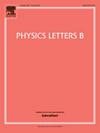The inevitable quark three-body force and its implications for exotic states
IF 4.3
2区 物理与天体物理
Q1 ASTRONOMY & ASTROPHYSICS
引用次数: 0
Abstract
Three-body nuclear forces are essential for explaining the properties of light nuclei with a nucleon number greater than three. Building on insights from nuclear physics, we extract the form of quark three-body interactions and demonstrate that these terms are crucial for extending the quark model fit of the meson spectrum to include baryons using the same parameter set. We then discuss the implications of our findings for exotic configurations involving more than three quarks, such as the and . We find that the quark three-body interactions, which are valid at short ranges typical of a compact hadron, provide additional repulsion of more than 10 MeV for the compact configurations of both the and . Since most of the previous quark model calculations based on two-body quark interactions do not find the energies of compact configurations for the and to be as attractive as 10 MeV below the threshold, our results strongly suggest that these tetraquark states are unlikely to be compact states, leaving the molecular configuration as the likely viable option.
求助全文
约1分钟内获得全文
求助全文
来源期刊

Physics Letters B
物理-物理:综合
CiteScore
9.10
自引率
6.80%
发文量
647
审稿时长
3 months
期刊介绍:
Physics Letters B ensures the rapid publication of important new results in particle physics, nuclear physics and cosmology. Specialized editors are responsible for contributions in experimental nuclear physics, theoretical nuclear physics, experimental high-energy physics, theoretical high-energy physics, and astrophysics.
 求助内容:
求助内容: 应助结果提醒方式:
应助结果提醒方式:


